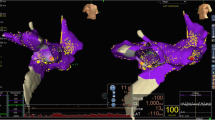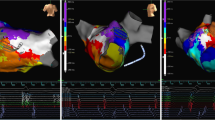Abstract
Aims
We used a new grid-style multi-electrode mapping catheter (Advisor™ HD Grid, Abbott) and investigated its use for high density mapping of atrial tachycardias in adult patients with congenital heart disease.
Patients and methods
All patients with congenital heart disease who had mapping of atrial tachycardias using the new grid-style catheter between March 2018 and April 2019 were included.
Results
A total of 24 adult patients had high density mapping of atrial tachycardias using the grid-style multi-electrode catheter. Mean procedure duration was 207 ± 72 min., mean fluoroscopy time was 7.1 ± 7.9 min. In patients with right atrial substrates, fluoroscopy time was shorter compared to biatrial or left atrial substrates (0.9 ± 2.2 min for right atrial substrates, n = 19 vs. 6.3 ± 8.3 min for left atrial substrates, n = 2 and 7.5 ± 4.3 min for biatrial substrates, n = 3, p = 0.01). A mean number of 14.814 ± 10.140 endocardial points were collected and 2.319 ± 1244 points were finally used to characterize the tachycardia. Procedural success was achieved in 21/24 (88%) subjects and partial success in 2/24 (8%) patients. Recurrence rate was low (12.5%). In one patient, radiofrequency ablation within the cavotricuspid isthmus resulted in occlusion of a branch of the right coronary artery. No complications related to the use of the mapping catheter itself occurred.
Conclusion
High density mapping of AT using the grid-style catheter showed promising results with respect to procedural and midterm outcome and fluoroscopy time. Using the grid-style catheter might offer advantages compared to other multi-electrode catheters used for high density mapping of AT in patients with CHD.






Similar content being viewed by others
Abbreviations
- ACT:
-
Activated clotting time
- ASD:
-
Atrial septal defect
- AT:
-
Atrial tachycardia
- AVSD:
-
Atrioventricular septal defect
- CHD:
-
Congenital heart disease
- CL:
-
Cycle length
- CoA:
-
Coarctation of the aorta
- DILV:
-
Double inlet left ventricle
- dTGA:
-
Dextro-transpostion of the great arteries
- EPS:
-
Electrophysiological study
- HD:
-
High density
- LA:
-
Left atrium
- MS:
-
Mitral stenosis
- NTG:
-
Nitroglycerin
- PAPVD:
-
Partial anomalous pulmonary venous drainage
- RA:
-
Right atrium
- RCA:
-
Right coronary artery
- RF:
-
Radiofrequency current
- SVAS:
-
Supravalvular aortic stenosis
- TA:
-
Tricuspid atresia
- TOF:
-
Tetralogy of Fallot
- VSD:
-
Ventricular septal defect
References
Kaemmerer H, Bauer U, Pensl U, Oechslin E, Gravenhorst V, Franke A et al (2008) Management of emergencies in adults with congenital cardiac disease. Am J Cardiol 101(4):521–525
Sherwin ED, Triedman JK, Walsh EP (2013) Update on interventional electrophysiology in congenital heart disease: evolving solutions for complex hearts. Circ Arrhythm Electrophysiol 6(5):1032–1040
Saul JP, Kanter RJ, Writing C, Abrams D, Asirvatham S, Bar-Cohen Y et al (2016) PACES/HRS expert consensus statement on the use of catheter ablation in children and patients with congenital heart disease: developed in partnership with the Pediatric and Congenital Electrophysiology Society (PACES) and the Heart Rhythm Society (HRS). Endorsed by the governing bodies of PACES, HRS, the American Academy of Pediatrics (AAP), and the American Heart Association (AHA). Heart Rhythm 13:251–289
Khairy P, Van Hare GF, Balaji S, Berul CI, Cecchin F, Cohen MI et al (2014) PACES/HRS expert consensus statement on the recognition and management of arrhythmias in adult congenital heart disease. Heart Rhythm 11(10):e102–e165
Ernst S, Cazzoli I, Guarguagli S (2019) An initial experience of high-density mapping-guided ablation in a cohort of patients with adult congenital heart disease. Europace 21(Supplement_1):i43–i53
Xue Y, Liu Y, Liao H, Zhan X, Fang X, Deng H et al (2018) Evaluation of electrophysiological mechanisms of post-surgical atrial tachycardias using an automated ultra-high-density mapping system. JACC Clin Electrophysiol 4(11):1460–1470
Mantziari L, Butcher C, Shi R, Kontogeorgis A, Opel A, Chen Z et al (2019) Characterization of the mechanism and substrate of atrial tachycardia using ultra-high-density mapping in adults with congenital heart disease: impact on clinical outcomes. J Am Heart Assoc 8(4):e010535
Walsh KA, Galvin J, Keaney J, Keelan E, Szeplaki G (2018) Automated ultra-high-density mapping of peri-sinus node premature atrial contractions. Clin Res Cardiol 107(4):368–370
Lugenbiel P, Xynogalos P, Schweizer P, Katus HA, Thomas D, Scholz EP (2018) Successful localization and ablation of a Mahaim potential using a high-resolution mapping catheter after a failed conventional ablation attempt. Clin Res Cardiol 107(7):607–610
Krause U, Backhoff D, Klehs S, Schneider HE, Paul T (2016) Transbaffle catheter ablation of atrial re-entrant tachycardia within the pulmonary venous atrium in adult patients with congenital heart disease. Europace 18(7):1055–1060
Triedman JK, DeLucca JM, Alexander ME, Berul CI, Cecchin F, Walsh EP (2005) Prospective trial of electroanatomically guided, irrigated catheter ablation of atrial tachycardia in patients with congenital heart disease. Heart Rhythm 2(7):700–705
Klehs S, Schneider HE, Backhoff D, Paul T, Krause U (2017) Radiofrequency catheter ablation of atrial tachycardias in congenital heart disease: results with special reference to complexity of underlying anatomy. Circ Arrhythm Electrophysiol 10(12):e005451
Krause U, Backhoff D, Klehs S, Schneider HE, Paul T (2016) Contact force monitoring during catheter ablation of intraatrial reentrant tachycardia in patients with congenital heart disease. J Interv Cardiac Electrophysiol Int J Arrhythm Pacing 46(2):191–198
Schoene K, Rolf S, Schloma D, John S, Arya A, Dinov B et al (2015) Ablation of typical atrial flutter using a non-fluoroscopic catheter tracking system vs. conventional fluoroscopy-results from a prospective randomized study. Europace 17(7):1117–1121
Alken FA, Klatt N, Muenkler P, Scherschel K, Jungen C, Akbulak RO et al (2019) Advanced mapping strategies for ablation therapy in adults with congenital heart disease. Cardiovasc Diagn Ther 9(Suppl 2):S247–S263
Pothineni NV, Kancharla K, Katoor AJ, Shanta G, Paydak H, Kapa S et al (2019) Coronary artery injury related to catheter ablation of cardiac arrhythmias: a systematic review. J Cardiovasc Electrophysiol 30(1):92–101
Funding
This research did not receive any specific grant from funding agencies in the public, commercial, or not-for-profit sectors.
Author information
Authors and Affiliations
Corresponding author
Ethics declarations
Conflict of interest
None declared.
Rights and permissions
About this article
Cite this article
Krause, U., Müller, M.J., Stellmacher, C. et al. High density mapping and catheter ablation of atrial tachycardias in adults with congenital heart disease. Clin Res Cardiol 109, 999–1007 (2020). https://doi.org/10.1007/s00392-019-01592-x
Received:
Accepted:
Published:
Issue Date:
DOI: https://doi.org/10.1007/s00392-019-01592-x




